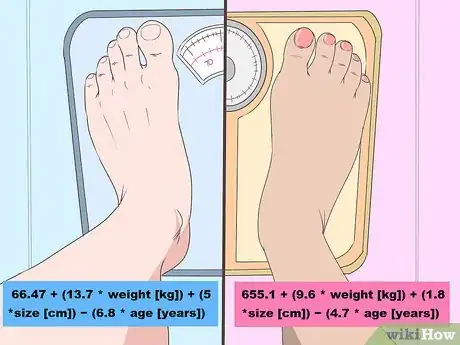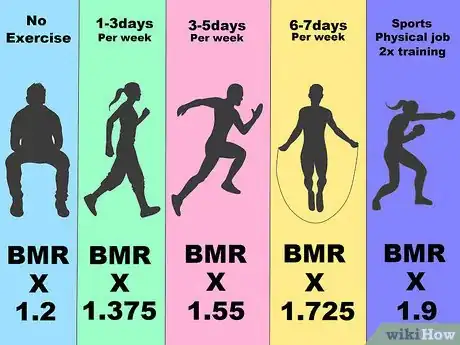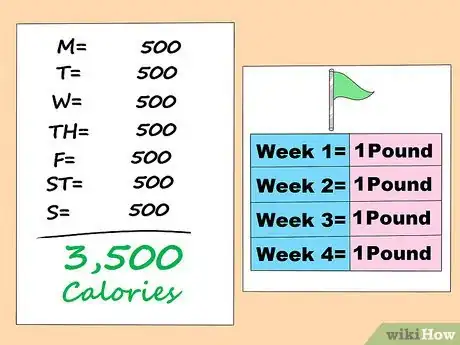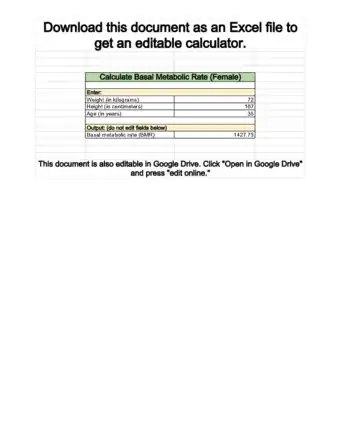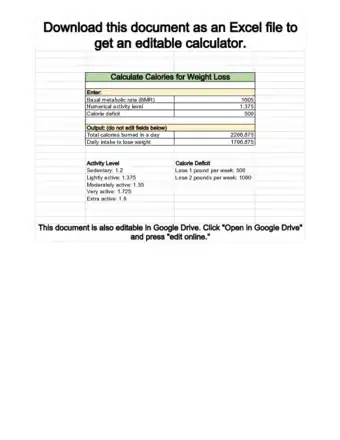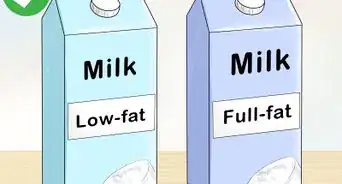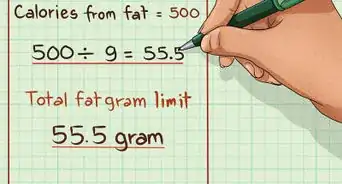This article was co-authored by Courtney Fose, RD, MS. Courtney Fose is a Registered Dietitian and Certified Nutrition Support Clinician at the University of Arkansas for Medical Sciences. She has worked as a Dietitian since 2009, and received her MS in Clinical Nutrition from the University of Arkansas in 2016.
wikiHow marks an article as reader-approved once it receives enough positive feedback. In this case, several readers have written to tell us that this article was helpful to them, earning it our reader-approved status.
This article has been viewed 1,483,948 times.
There are a variety of methods available to help people lose weight. Following a healthy diet and cutting calories is the safest and most practical way to lose weight. Figuring out how many calories your body needs and how many you should cut out to help you lose weight can be confusing and difficult to calculate. There are a variety of equations, estimations and graphs that can help you calculate a calorie level that will help you lose weight. Outside of using an online calculator or chart, there are equations that you can use to find a specific calorie target for your body.
Steps
Calculating Your Calorie Needs
-
1Calculate your basal metabolic rate (BMR). Your BMR will tell you how many calories your body needs to function properly if you spent the entire day doing absolutely nothing. This is also known as your metabolic rate or metabolism.
- Your body burns calories just to fulfill life-sustaining processes like breathing, digesting food, repairing and growing tissue and circulating blood.[1]
- You will use the results from the BMR equation to find out how many calories you need to either lose weight or maintain your weight.
- Use the following equation (known as the Harris Benedict Equation) that is commonly used by health professionals to determine calorie needs. for men: 66.47 + (13.7 * weight [kg]) + (5 * size [cm]) − (6.8 * age [years])[2]
- Use the following equation for women: 655.1 + (9.6 * weight [kg]) + (1.8 * size [cm]) − (4.7 * age [years])[3]
-
2Account for your activity level. In addition to essential bodily functions, you must also account for the calories you burn through daily activity.[4] Once you have your BMR, multiply your BMR by the appropriate activity factor:
- If you are sedentary (little or no exercise) : BMR x 1.2
- If you are lightly active (light exercise/sports one to three days/week) : BMR x 1.375
- If you are moderately active (moderate exercise/sports three to five days/week) : BMR x 1.55
- If you are very active (hard exercise/sports six to seven days a week) : BMR x 1.725
- If you are extra active (very hard exercise/sports and physical job or 2x training) : BMR x 1.9
- For example, a 19-year-old woman who is 5’5” and 130 pounds would plug her information into the calculator and find out that her BMR is 1,366.8 calories. Then, since she is moderately active, exercising three to five days per week, she would multiply 1,366.8 by 1.55, to equal 2,118.5 calories. That is the number of calories that her body burns on an average day.
Advertisement -
3Calculate your total calorie needs for weight loss. In order to lose 1 pound of fat each week, you must have a deficit of 3,500 calories over the course of a week.[5]
- Cutting out about 500 calories each day will result in a 3,500 calorie deficit over the course of the entire week.
- Only aim to lose 1 or 2 pounds per week. If you were to lose weight through diet alone, you'd need a 500-calorie deficit every day to lose one pound in a week. If you were really pushing it and wanted to lose 2 pounds in a week, you'd need a 1,000-calorie deficit every day.[6]
- Aim to cut calories out by decreasing how much you eat in addition to burning off calories through physical activity. This combination generally produces the most effective weight loss.
Using Calories Calculations to Manage Your Weight
-
1Keep track of how many calories you currently eat each day. When you first start your attempt to lose weight, it may be helpful to keep track of how many calories you're currently eating.
- Keep a food journal or use an online calculator to help you get an estimate of how much you currently consume.
- Compare this amount to your calculated and activity-adjusted BMR. If the numbers aren't even remotely close, it may be easier to start your diet by consuming your calculated amount of calories daily.
- Consuming a significant amount of calories less than you're typical day might be difficult. Decrease slowly by first adjusting your diet to line up with your activity-adjusted BMR level.
-
2Don't eat less than your calculated BMR. It's a bad idea to consistently make your daily caloric intake lower than your BMR. When your body doesn't take in enough calories each day to sustain basic functions, it starts burning muscle for energy.[7] This will make maintaining your weight loss more difficult in the long run.
- Very low calorie diets aren't typically considered safe or appropriate for weight loss. They do not provide enough flexibility for you consume an adequate amount of protein, vitamins or minerals that are essential to your health.[8]
- Try to keep consume at least 1,200 calories daily. This is generally recommended to by the absolute lowest amount of calories to take in daily.
-
3Keep a food journal. Consider keeping a food journal that lists everything you eat, as well as the calories per serving and how many servings you had. Studies show that those who journal their foods regularly stick to their diet plans longer and lose more weight.[9]
- Search online for free apps or websites that allow you to enter what you ate — some will even calculate the calories for you. Try MyFitnessPal or Super Tracker by the USDA. You can also log your activity level and the amount of exercise you get each day.
- Seeing the actual amount of calories you consume each day will force you to take responsibility for your health and cut back on eating. Be vigilant about logging everything that goes into your mouth, and you'll find it's easier to stick to your diet.
-
4Weigh yourself regularly. Another important component of weight loss is tracking your weight and overall progress.
- Studies have shown that those dieters who weighed themselves regularly were more successful long-term than those who didn't keep track on their weight.[10]
- Weigh yourself about one to two times per week. Try to get on the scale at the same time of day (try for first thing in the morning after you've just emptied your bladder) while you're wearing the same clothes for the most accurate record of progress.
- If you're not losing weight, reevaluate your total calorie intake. You may need to cut out more calories or be more accurate with your food journaling.
Basal Rate Calculators
Help Calculating Calories
Expert Q&A
-
QuestionDoes drinking cold water will matter while you are on your diet?
 Courtney Fose, RD, MSCourtney Fose is a Registered Dietitian and Certified Nutrition Support Clinician at the University of Arkansas for Medical Sciences. She has worked as a Dietitian since 2009, and received her MS in Clinical Nutrition from the University of Arkansas in 2016.
Courtney Fose, RD, MSCourtney Fose is a Registered Dietitian and Certified Nutrition Support Clinician at the University of Arkansas for Medical Sciences. She has worked as a Dietitian since 2009, and received her MS in Clinical Nutrition from the University of Arkansas in 2016.
Master's Degree, Clinical Nutrition, University of Arkansas for Medical Sciences Master's Degree, Clinical Nutrition, University of Arkansas for Medical SciencesExpert AnswerThere is rumor that drinking cold water will burn calories as your body needs to warm the water up to 98.6 degrees before we can absorb it. Research has shown that drinking a glass of water will burn 8 calories. If you do this every day for 1 year, it will burn 2,920 calories, which is less than 1 pound of weight loss. So, it’s probably not your best weight loss option.
Master's Degree, Clinical Nutrition, University of Arkansas for Medical SciencesExpert AnswerThere is rumor that drinking cold water will burn calories as your body needs to warm the water up to 98.6 degrees before we can absorb it. Research has shown that drinking a glass of water will burn 8 calories. If you do this every day for 1 year, it will burn 2,920 calories, which is less than 1 pound of weight loss. So, it’s probably not your best weight loss option. -
QuestionDo you eat fewer calories than than the result of your multiplied BMR?
 Courtney Fose, RD, MSCourtney Fose is a Registered Dietitian and Certified Nutrition Support Clinician at the University of Arkansas for Medical Sciences. She has worked as a Dietitian since 2009, and received her MS in Clinical Nutrition from the University of Arkansas in 2016.
Courtney Fose, RD, MSCourtney Fose is a Registered Dietitian and Certified Nutrition Support Clinician at the University of Arkansas for Medical Sciences. She has worked as a Dietitian since 2009, and received her MS in Clinical Nutrition from the University of Arkansas in 2016.
Master's Degree, Clinical Nutrition, University of Arkansas for Medical Sciences Master's Degree, Clinical Nutrition, University of Arkansas for Medical SciencesExpert AnswerYou should not eat less than your BMR, it would be more appropriate to exercise enough to put your total calories into a deficit below your BMR.
Master's Degree, Clinical Nutrition, University of Arkansas for Medical SciencesExpert AnswerYou should not eat less than your BMR, it would be more appropriate to exercise enough to put your total calories into a deficit below your BMR.
References
- ↑ http://www.mayoclinic.org/healthy-lifestyle/weight-loss/in-depth/metabolism/art-20046508?pg=1
- ↑ http://www.diabetes.co.uk/bmr-calculator.html
- ↑ http://www.diabetes.co.uk/bmr-calculator.html
- ↑ http://www.diabetes.co.uk/bmr-calculator.html
- ↑ http://www.mayoclinic.org/healthy-lifestyle/weight-loss/in-depth/weight-loss/art-20047752
- ↑ http://www.mayoclinic.org/healthy-lifestyle/weight-loss/in-depth/weight-loss/art-20047752
- ↑ http://www.mayoclinic.org/healthy-lifestyle/weight-loss/in-depth/weight-loss/art-20047752
- ↑ http://www.mayoclinic.org/healthy-lifestyle/weight-loss/in-depth/weight-loss/art-20047752
- ↑ http://www.sciencedaily.com/releases/2008/07/080708080738.htm
About This Article
To calculate how many calories you need to eat to lose weight, calculate your basal metabolic rate, which tells you how many daily calories you need to keep your body functioning. Next, multiply your BMR by the activity factor representing the number of daily calories you burn through activity. To lose 1 pound of fat each week, you need a deficit of 3,500 calories over the course of a week. Use your updated BMR to figure out how many daily calories you need to cut to achieve a 3,500 weekly deficit! For tips on tracking your caloric intake each day, read on!
